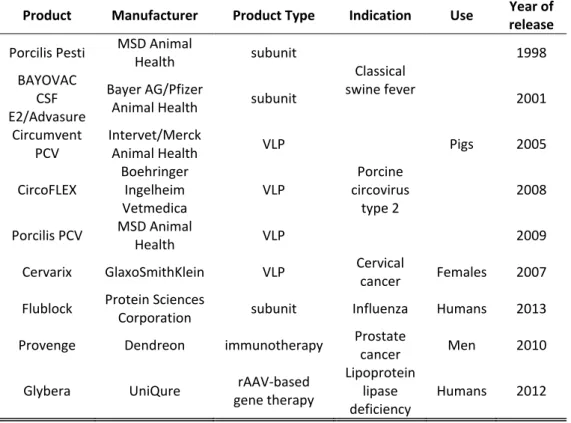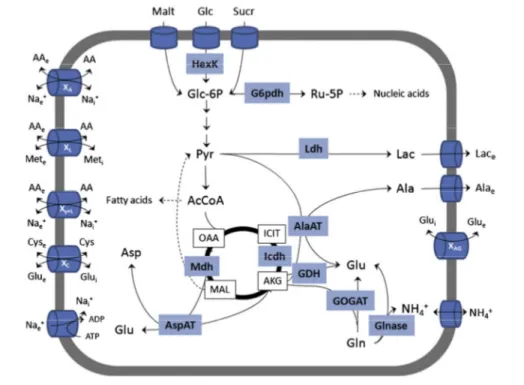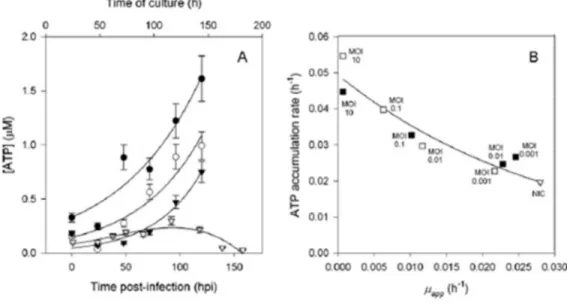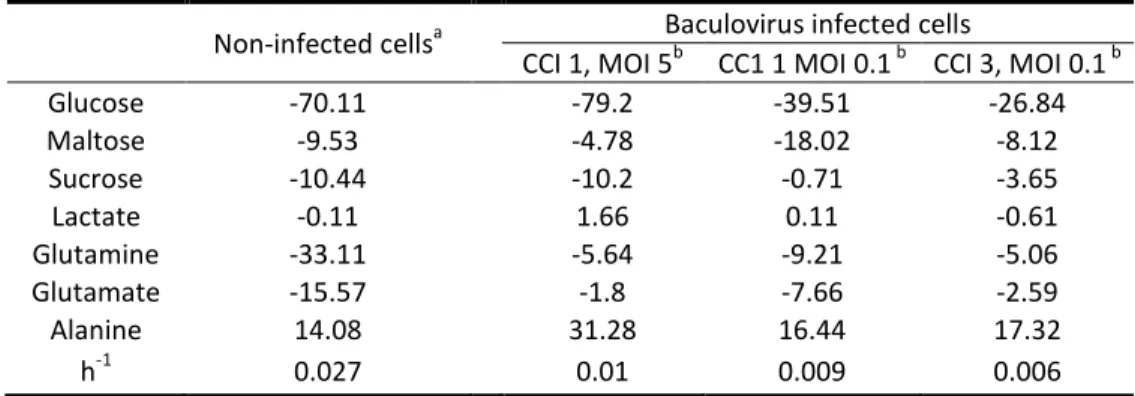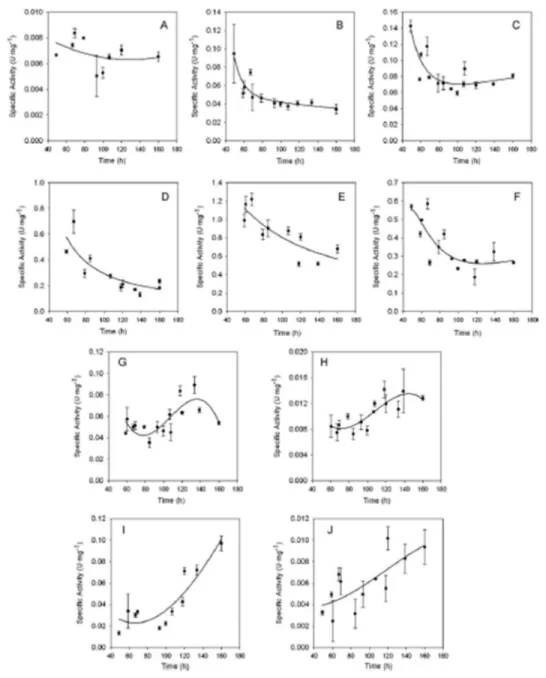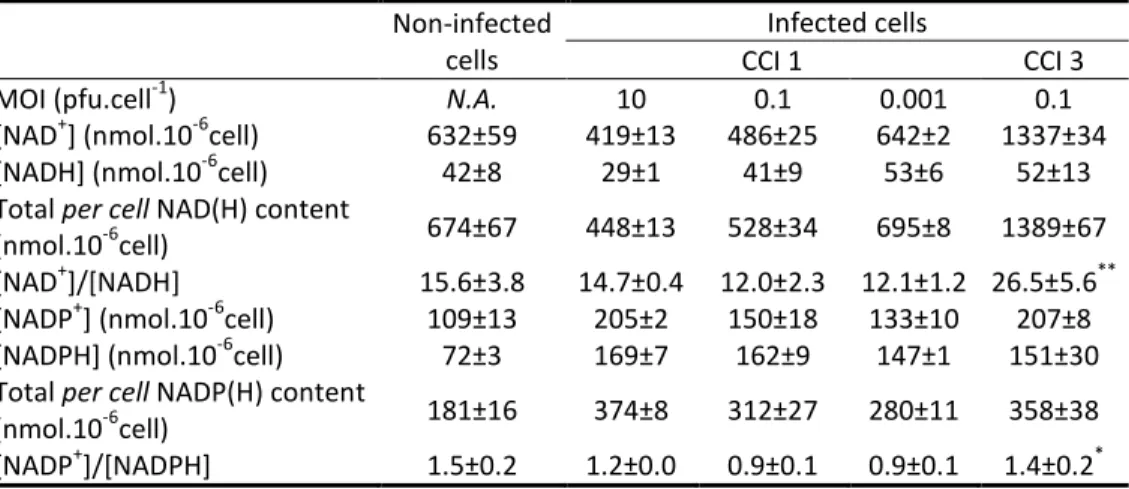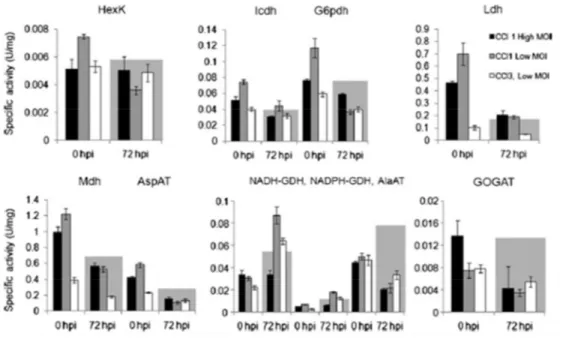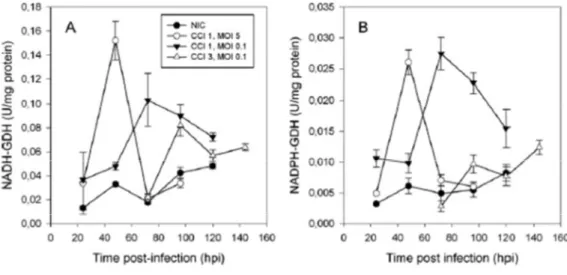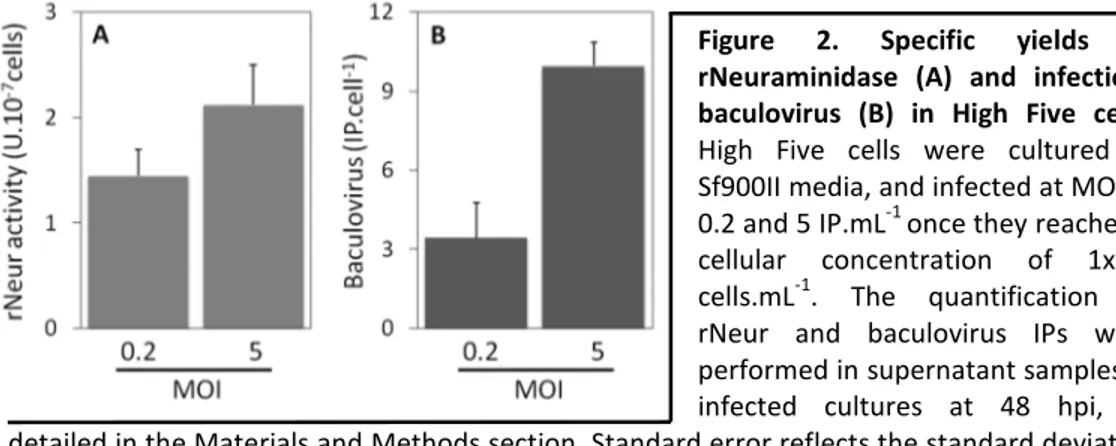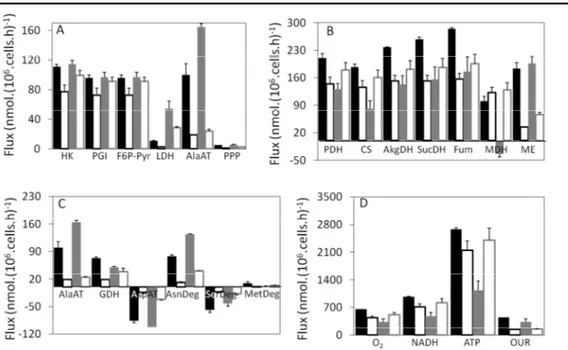Francisca Monteiro
Dissertation presented to obtain the Ph.D degree in Engineering
and Technology Sciences-Biotechnology
Instituto de Tecnologia Química e Biológica António Xavier | Universidade Nova de Lisboa
Oeiras,
September, 2015
Rational design of insect cell-based
vaccine production
Francisca Monteiro Rational design of insect cell-based vaccine production
Francisca Sarreira Simões Horta Monteiro
Dissertation presented to obtain the Ph.D degree in Engineering
and Technology Sciences-Biotechnology
Instituto de Tecnologia Química e Biológica António Xavier | Universidade Nova de Lisboa
Oeiras, September, 2015
Rational design of insect
cell-based vaccine production
R
ATIONAL DESIGN OF INSECT CELL
-
BASED VACCINE PRODUCTION
Bridging metabolomics with mathematical tools to study virus-host
interactions
Francisca Sarreira Simões Horta Monteiro
Dissertation presented to obtain a Ph.D. degree in Engineering and Technology
Sciences, Biotechnology
Instituto de Tecnologia Química e Biológica António Xavier, Universidade Nova de
Lisboa
Supervisor: Paula Marques Alves
Co-supervisor: Vicente Bernal Sanchez
Oeiras, September, 2015
ii Rational design of insect cell-based vaccine production
Bridging metabolomics with mathematical tools to study virus-host interactions
By Francisca Monteiro
First edition: August 2015
Cover: Combined figure of a diagram of a metabolic network of cellular metabolism and a baculovirus particle.
ITQB-UNL/iBET Animal Cell Technology Unit
Instituto de Tecnologia Química e Biológica/
Instituto de Biologia Experimental e Tecnológica
Av. da República EAN, 2780-157 Oeiras, Portugal
http://tca.itqb.unl.pt
http://www.itqb.unl.pt
http://www.ibet.pt
Copyright ©2015 by Francisca Monteiro
All rights reserved
iii
Supervisors:
Dr. Paula Marques Alves, Invited Associate Professor at Faculdade de Ciências e
Tecnologia, UNL, Caparica, Portugal, Principal Investigator at ITQB-UNL, Director of
Animal Cell Technology Unit, ITQB-UNL, Oeiras, Portugal, , CEO of IBET (Supervisor).
Dr. Vicente Bernal, Scientist, Biology Area - New Energies - Technology Center,
Repsol S.A, previously Researcher at Departamento de Bioquímica y Biología
Molecular B e Inmunología, Universidad de Murcia, Murcia, Spain (Co-supervisor).
Jury:
Dr. Otto-Wilhelm Merten, Head of the Applied Vectorology and Innovation group of
Généthon, Généthon, Évry, France
Dra. Isabel Rocha, Assistant Professor at Department of Biological Engineering,
Universidade do Minho, Braga, Portugal, Researcher at Institute for Biotechnology
and Bioengineering, Center of Biological Engineering, Universidade do Minho, Braga,
Portugal.
Dr. Guilherme Ferreira, Assistant Professor with Aggregation at Universidade do
Algarve, Faro, Portugal, Principal Investigator at Biosensors and Bioengineering
laboratory, Universidade do Algarve, Faro, Portugal, and Director of Center for
Biomedical Research.
Prof. Manuel J. T. Carrondo, Professor of Chemical and Biochemical Engineering at
Faculdade de Ciências e Tecnologia, UNL, Caparica, Portugal, Head of the Engineering
Cellular Applications Laboratory from Animal Cell Technology Unit, ITQB-UNL, Oeiras,
iv
Foreword
The present thesis dissertation is the result of four years of research at the
Animal Cell Technology Unit of ITQB-UNL/iBET, Oeiras, Portugal, under the
supervision of Dr. Paula Marques Alves and Dr. Vicente Bernal.
This PhD thesis aimed at improving insect cell-based bioprocesses via baculovirus
expression for the production of complex biopharmaceuticals, using metabolomics
and fluxomics tools to extend the knowledge on the physiology and metabolic
v
Acknowledgments
I would like to express my gratitude to all the people that contributed directly or indirectly to this thesis. Also, to the hosting institutions, iBET and ITQB, for the excellent working conditions.
To my supervisor, Dr. Paula M. Alves, for giving me the opportunity to join the animal cell technology unit (ACTU) and the scientific support invaluable for the work herein presented. For the vote of confidence that enabled me to grow as scientist, for pushing me forward and promoting my independence. For teaching me that a PhD journey goes beyond science, placing me in confrontation with my own beliefs, which undoubtedly promoted my development as an individual.
To my co-supervisor, Dr. Vicente Bernal, for the guidance and scientific support throughout these years. For his truly scientific soul and devoted mentoring that always inspired me, his critical insights and for broadening my scientific perspectives. For welcoming me at University of Murcia, for his friendship and for making me feel a peer.
To Prof. Manuel Carrondo for truly being an entrepreneur and founding iBET, an institute in which I have the privilege to work. For the example of determination and motivation in fighting for his own beliefs, and for teaching me to always reach out for the best.
To Prof. Manuel Cánovas, for welcoming me at his lab in Universidad de Murcia. For making me feel a member, for his scientific advices and for the working conditions provided.
To Dr. Imre Berger for accepting me in his lab at EMBL Grenoble. For the excellent working conditions provided and the scientific enthusiasm in our discussions. Also, to Maxime Chaillet for all the help, technical support and good will during my staying.
To the financial support provided by Fundação para a Ciência e Tecnologia (SFRH/BD/70139/2010) and by European Commission, through the FP7 project ComplexInc.
vi To my colleagues of the insect cell task force, João and Mafalda, for sharing with me the hurdles and joys of working with such amazing cell lines. To Ana Sofia, Carina, Daniel S., Marta S., Tiago D., Fabiana and Hugo for the support and making my daily life in the lab happier. To Sofia Rebelo, for her truly and honest companionship, kindness and support.
À minha colega e amiga Filipa, companheira de tantas e todas as horas. Agradeço-te por seres quem és, pelo teu entusiasmo contagiante, pelas longas conversas e acesas trocas de ideias. Há pessoas que entram na nossa vida e que, por a enriquecerem tremendamente, não as devemos deixar sair. Tu és uma dessas pessoas!
Aos meus companheiros e amigos de luta Paulo, Zeca, Dimi e Alex. O equilibrio comanda a vida, e a minha sem qualquer um de vós seria inevitalvelmente sensaborona. Em especial ao Paulo, por reunires em ti tantos bocadinhos bons de felicidade: passados, presentes e, sem qualquer dúvida, futuros.
Aos meus amigos Catarina, Grilo, Sofia, Mafalda e Raquel, pelo companheirismo e amizade, pelas gargalhadas e momentos únicos que tanto me enriquecem.
Às minhas amigas Ivette e Laura, mulheres incríveis, cuja força e coragem extraordinárias são inspiradoras. Obrigada por partilharem comigo a vossa jornada.
Aos meus anjos em vida, Filipa e Rita. A amizade incondicional é um privilégio raro de alcançar, pelo que sou uma afortunada em ter-vos comigo.
À minha família, turbilhão e Norte da minha vida. Às minhas madrinhas e avós Maria do Céu e Clara, verdadeiras forças da Natureza que me completam e constituem. Aos meus avôs Sebastião e José, meus pilares de força e abrigo.
À minha mãe, pequeno génio provido de amor e apoio incondicionais, ao meu pai, espírito livre e génio criativo de tremenda sensibilidade. Aos meus queridos irmãos Ruizinho e Madalena, eternos companheiros e cúmplices, mesmo na ausência de palavras. Trago em mim um pedaço de todos vós!
vii
À memória do meu avô Sebastião,
Ao meu avô José
“A suposição de que a identidade de uma pessoa transcende, em grandeza e importância, tudo o que ela possa fazer ou produzir é um elemento indispensável da dignidade humana.”
viii
Abstract
The increasing demand of baculovirus- based biopharmaceuticals raises the
interest in developing high-titer production processes. Baculovirus infection boosts
the host biosynthetic activity towards the production of viral components and the
recombinant protein of interest, hyper-productive phenotypes being the result of a
successful adaptation of the cellular network to that scenario. Thus, the
comprehensive knowledge of the host cell metabolism, mainly in the post-infection
phase, can provide clues on the metabolic adaptations that occur and, ultimately, aid
bioprocess engineers in developing rational and targeted optimization strategies.
This PhD work aimed at improving insect cell-based bioprocesses via baculovirus
expression for the production of complex biopharmaceuticals, ranging from
recombinant proteins to multiprotein complexes as novel vaccine candidates, and
baculovirus vectors with improved titers and quality. A thorough metabolic analysis
and characterization of the IC-BEVS system was attained to support the rational
bioprocess optimization, having present the physiological determinants that
contribute to productivity, as well as the target requirements for enhanced product
quality.
In Chapter II, the combined analysis of enzyme activities with metabolic fluxes
retrieved noteworthy insights on the metabolism of Sf9 cells, with the identification
of possible limiting steps of metabolic activity. Additionally, as a consequence of
baculovirus infection, key enzymes controlling the flux via anaplerotic reactions were
identified has being greatly activated. High Five cells were analyzed by MFA (Chapter
III); the cellular metabolic efficiency was identified to be directly correlated with the
culture media used, which impacted the level of by-products accumulation
throughout culture time. In addition, oxidative metabolism was hampered in High
Five cells, which correlates with the carbon overflow towards lactate and alanine
production. A comparative fluxome analysis of Sf9 and High Five cells metabolism
ix followed growth and infection (Chapter IV). A high dependence of amino acid
metabolism and anaplerosis was observed in High Five cells, to counteract the lower
channeling of glucose to the TCA cycle. After baculovirus infection, the metabolic
activity was rearranged, and the channeling of glucose towards pyruvate formation
and further oxidation at the TCA cycle was much more efficient. The strong
correlation observed between the metabolic state of both host cells with baculovirus
infection highlights the capacity of this virus to act as a metabolic engineer,
re-directing the cellular fluxome to support viral replication and virions production.
Although meaningful insights were provided by the fluxome description of Sf9
and High Five cells, is difficult to perceive if the changes in the metabolic fluxes are
related to lower enzymatic activities of key regulatory enzymes, or even with
perturbations on the intracellular metabolite pools. In this regard, extra and
intracellular metabolite quantification was pursued to directly visualize the main
compensatory events that occurred on the host cell metabolism (Chapter V).
Infection impact was considerably higher in High Five cells, with a myriad of
metabolic pathways being hijacked to support massive production of heterologous
proteins and viral particles. Specifically, amino acid metabolism, redox homeostasis,
glutathione and taurine metabolism, and nucleosides biosynthetic pathways were
highlighted as being regulated upon baculovirus infection. This information was then
applied to design tailored supplementation schemes to boost IC-BEVS production
yields of three targets with increasing complexity: recombinant influenza
neuraminidase (rNeur); enveloped influenza VLPs (Inf-VLP) and the baculovirus itself
(BV) (Chapter VI). Higher rNeur yields were achieved when supplementing High Five
cultures with cholesterol; for Sf9 cells, GSH, antioxidants combined with polyamines,
and cholesterol yielded the best outputs during InfVLPs and infectious BVs
production. The fine tuning of the MOI, along with the enhancement of redox and
cholesterol metabolism, yielded an improvement of the systems’ specific productivity
x coupled with an enhanced cholesterol metabolism, are key parameters that should
be considered when developing and implementing highly productive bioprocesses.
The scarcity of fundamental knowledge on the baculovirus-host cell interaction is
a major drawback for the improvement of bioprocesses through Metabolic
Engineering. Virus-based bioprocesses are highly dependent on the proper infection
of the producer cell, as well as efficient viral replicative cycle and expression of the
heterologous genes. This thesis contributed to extend that landscape, by enlarging
the knowledge on the physiology and metabolic requirements of insect cells for the
xi
Resumo
A crescente procura por biofármacos produzidos pelo sistema de expressão
baculovirus-célula de insecto torna clara a necessidade de desenvolver processos de
produção altamente eficientes e produtivos. Após a infecção pelo baculovirus, a
capacidade biosintética da célula hospedeira é levada ao limite com o objectivo de
produzir não só os vários componentes virais como também a proteína recombinante
de interesse. Os estados celulares considerados hiper productivos reflectem o
sucesso da adpatação da célula hospedeira ao cenário de infecção. Assim sendo, o
estudo do metabolismo celular, principalmente no cenário pós-infecção, poderá
fornecer pistas acerca das adaptações metabólicas que ocorrem durante este
processo e, em última instância, contribuir para o desenvolvimento e implementação
de estratégias de optimização do bioprocesso e engenharia metabólica.
Esta tese de doutoramento teve como objectivo optimizar o sistema de
expressão baculovirus-célula de insecto para produção de biofármacos complexos,
desde proteínas recombinantes a partículas semelhantes a vírus que podem ser
usadas como vacinas e vectores virais, em maior quantidade e de qualidade superior.
De modo a optimizar este processo de expressão de uma forma racional,
procedeu-se à analiprocedeu-se do metabolismo celular, dando especial atenção aos determinantes
fisiológicos e requisitos bioquímicos do produto alvo que contribuem para uma maior
productividade e qualidade do mesmo.
No Capítulo II, a análise combinada dos fluxos metabólicos e actividades
enzimáticas revelou dados importantes acerca da actividade metabólica das células
de insecto Sf9, como por exemplo a identificação das vias metabólicas
potencialmente limitantes. Mais ainda, foi observado um aumento na actividade de
enzimas de vias anapleróticas como consequência da infecção viral. Procedeu-se
igualmente à análise dos fluxos metabólicos nas células High Five (Capítulo III),
tendo-se observado que a eficiência metabólica destas células está directamente
correlacionada com o meio de cultura usado, o qual influencia os níveis de produção
xii observado que o metabolismo oxidativo das células High Five se encontra limitado,
levando à produção e acumulação excessiva de lactato e alanina. O metabolismo das
duas células de insecto mais utilizadas pela indústria, Sf9 e High Five, foi analisado e
comparado através da análise quantitativa dos fluxos metabólicos (Capítulo IV). Os
resultados obtidos indicam que as células High Five estão altamente dependentes da
actividade anaplerótica e do metabolismo amino acídico como forma de
contrabalançar o reduzido direccionamento de glucose para o ciclo dos ácidos
tricarboxílicos (ATC). Após a infecção com baculovirus, a actividade metabólica da
célula sofre um rearranjo significativo, tornando o direccionamneto de glucose para
formação de piruvato e subsequente incorporação no ciclo dos ACT muito mais
eficiente. Todos estes estudos sugerem que o baculovirus tem um papel activo na
reorganização da actividade metabólica das células hospedeiras, actuando ele
próprio como um engenheiro metabólico que controla e direciona a actividade
energética celular para suportar a sua própria replicação e progenia.
Apesar da análise do fluxoma das células Sf9 e High Five ter gerado conhecimento
aprofundado acerca da dinâmica do metabolismo celular antes e após infecção com
baculovirus, não foi possível aferir se as alterações nos fluxos metabólicos advêm de
diferenças nas actividades das enzimas que regulam essas vias, ou até mesmo de
flutuações na quantidade e disponibilidade dos metabolitos que actuam como
substratos. De modo a responder a esta questão, procedeu-se à quantificação dos
metabolitos extra e intracelulares como forma de visualizar diretamente quais os
eventos compensatórios que ocorrem no metabolismo das células Sf9 e High Five
durante o crescimento celular e após infecção com baculovirus (Capítulo V). O
impacto da infecção foi significativamente mais elevado nas células High Five, com
um elevado número de vias metabólicas a serem recrutadas/redireccionadas para
suportar a replicação viral e produção da proteína recombinante de interesse. Entre
as mais essenciais podemos incluir as vias metabólicas que pertencem ao
metabolismo de amino ácidos, glutationo, biotina, taurina, resposta ao stress
xiii usada para desenhar estratégias de suplementação de meios de cultura com o
objectivo de intensificar as vias identificadas por análise metabolómica e,
subsequentemente, potenciar a expressão de três produtos com elevado grau de
complexidade: i) proteína recombinante neuraminidase (rNeur), ii) partículas
envelopadas semelhantes a vírus compostas por proteínas de Influenza (Inf-VLPs), e
iii) baculovirus (BV) (Capítulo VI). Relativamente às células High Five, a adição de
colesterol ao meio de cultura promoveu um aumento na produção de rNeur por
célula. No caso das células Sf9, a adição de glutationo, antioxidantes, poliaminas e
colesterol resultou no aumento da produção de Inf-VLPs e de BVs por célula.
Conjugando a multiplicidade de infecção (MOI) com a intensificação do metabolismo
do colesterol e resposta ao stress oxidativo conseguiu-se um aumento de 6 vezes na
produção por células no caso células Sf9. Em suma, a manutenção do equilíbrio das
reacções de oxidação-redução e um metabolismo do colesterol mais eficiente são
parametros chave que devem ser considerados aquando do desenvolvimento e
implementação de bioprocessos altamente produtivos baseados no sistema
baculoviurs-célula de insecto.
O desenvolvimento de estratégias de optimização por engenharia metabólica é
limitado pelo pouco conhecimento dos processos chave que regulam a interacção do
baculovirus com a célula hospedeira. O sucesso de bioprocessos baseados em vírus é
extraordinariamente dependente da relação estabelecida entre o vírus e a célula,
bem como da eficiência do ciclo replicativo viral e expressão dos genes heterólogos.
Esta tese contribuíu para uma melhor compreensão do cénario de infecção em
células de insecto, proporcionando um conhecimento abrangente da fisiologia celular
e dos determinantes metabólicos envolvidos na produção de biofármacos
xiv
Thesis publications
Published:
1. Bernal V, Monteiro F, Carinhas N, Ambrósio R, Alves PM (2010). An integrated analysis of enzyme activities, cofactor pools and metabolic fluxes in baculovirus-infected Spodoptera frugiperda Sf9 cells. Journal of Biotechnology Nov;150(3):332-42.
2. Monteiro, F., Carinhas, N., Carrondo, M. J. T., Bernal, V., and Alves, P. M. (2012). Toward system-level understanding of baculovirus-host cell interactions: from molecular fundamental studies to large-scale proteomics approaches. Frontiers in Microbiology 3, 391.
3. Monteiro F, Bernal V, Saelens X, Lozano AB, Bernal C, Sevilla A, Carrondo MJ, Alves PM (2014). Metabolic profiling of insect cell lines: Unveiling cell line
determinants behind system's productivity. Biotechnology and
Bioengineering Apr;111(4):816-28
Submitted:
4. Monteiro F, Bernal V, Chaillet M, Berger I and Alves PM, Tackling bottlenecks in the IC-BEVS: Enhancing enveloped viral particles production by targeted supplementation design, (in revision);
In preparation:
5. Monteiro F, Bernal V and Alves PM, Metabolic fluxes of cultured High Five cells: the impact of culture media and baculovirus infection, (in preparation)
6. Monteiro F, Bernal V and Alves PM, Fluxome analysis of the IC-BEVS: The role of host cell line physiology in systems productivity, (in preparation)
Other publications in the scope of virus production:
xv
List of contents
Chapter I – Introduction ………. 1
Chapter II – Analysis of enzyme activities, cofactor pools and metabolic fluxes in baculovirus-infected insect cells……….. 25
Chapter III – Metabolic fluxes of cultured High Five cells: the impact of culture media and baculovirus infection………. 55
Chapter IV – Fluxome analysis of the IC-BEVS: The role of host cell physiology in systems productivity……….. 77
Chapter V – Metabolic Pathway Analysis of insect cell lines for the identification of productivity traits……… 107
Chapter VI – Tackling bottlenecks in IC-BEVS: enhancing productivity by targeted supplementation design………. 137
Chapter VII – Discussion………. 169
Chapter I
I
NTRODUCTION
Part of this chapter is adapted from the manuscript:
Chapter I
2
Contents
1. Baculovirus: valuable expression vectors and therapeutic viruses ... 3
1.1
Baculovirus biology and life cycle: from
in vivo
to
in vitro
cultures ... 3
1.2
Introduction to the baculovirus-insect cell system ... 5
1.3
Therapeutic and research applications of the baculovirus-insect cell
system ... 6
2. Baculovirus infection: impact on the host insect cells ... 8
2.1
Baculovirus subversion of host cell metabolism ... 8
2.2
Systems-level analysis of Baculovirus-Host cell interactions ... 12
3. Metabolic modelling for bioprocess engineering ... 15
4. Challenges in the baculovirus-insect cell system: the bioprocess
perspective ... 17
5. Scope of this thesis ... 18
6. Author contribution ... 19
Introduction
3
1.
Baculovirus: valuable expression vectors and therapeutic viruses
1.1
Baculovirus biology and life cycle: from
in vivo
to
in vitro
cultures
Baculoviruses (BVs) are rod-shaped viruses with double-stranded DNA genomes. They infect arthropods, mainly insects, a feature that encouraged their usage as ecologically friendly biopesticides (Miller, 1997). Later on, BVs started to be exploited as viral vectors for eukaryotic protein expression, which quickened the pace of their characterization at the cellular and molecular levels (Possee, 1993). The best-studied
member of this family, Autographa californica multicapsid nucleopolyhedrovirus (AcMNPV), encodes for 150 genes and its genome has been completely sequenced.
Baculoviruses have a biphasic replication cycle in the insect host, involving the formation of two types of virions, produced in different phases of the infection process: the occlusion-derived virions (ODVs), adapted for stability outside the insect
host, and the budded virions (BdVs), non-occluded and responsible for the systemic, cell to cell dissemination of the virus within the insect. Infection starts when insect larvae ingest the occlusion bodies (Keddie et al., 1989). When facing the alkaline conditions in the insect midgut, the occlusion body dissolves and the ODVs are
released (Wang and Granados, 1997). The replicative cycle begins when ODVs infect the midgut columnar epithelial cells via the PIF complex, which mediate virion-specific binding to receptors located at the membrane of midgut epithelial cells (Horton and Burand, 1993; Kikhno et al., 2002). Afterwards, viral entry occurs through membrane fusion of the virion envelope with the cellular microvilli, followed
by the release of the nucleocapsids into the cytoplasm. Nucleocapsids then migrate to the nucleus in a process that involves actin polymerization (Ohkawa et al., 2010). Once having reached the nucleus, the host cell RNA polymerase-dependent transcription of viral immediate-early/early genes initiates (0–6 h post-infection, hpi).
This set of genes encodes mainly for transactivators essential for viral gene expression and subversion of host cell activity (Passarelli and Miller, 1993). The transition from early to late phase is marked by the onset of viral DNA replication (6–
Chapter I
4
DNA replication occurs together with the expression of viral components necessary for the assembly of new nucleocapsids. The newly assembled nucleocapsids are transported from the nucleus to the plasma membrane for budding through
GP64-enriched areas, originating the budded viruses (BdVs; Passarelli, 2012). BdVs are non-occluded virions surrounded by a plasma membrane-derived envelope containing GP64 as a major structural protein (Washburn et al., 2003). BdVs are required for secondary infection: once released, they are transported through the hemolymph to infect new cells, a process which, in contrast to what is described for ODVs, is
undertaken by GP64 via clathrin-mediated endocytosis (Blissard and Wenz, 1992; Long et al., 2006). In this regard, BdVs are the virus form responsible for viral dissemination through the host, culminating in a systemic infection. A secondary infection cycle begins with the entrance of BdVs into another cell of the insect. After entering the cell, the infection process is similar to what happens in a primary
infection, with the nucleocapsids traveling to the nucleus for DNA replication and subsequent viral protein expression. The very late phase of infection (18 hpi) initiates with the expression of proteins that constitute the crystalline matrix of the ODVs, namely polyhedrin. After nucleocapsid assembly, they are enveloped by the
polyhedrin matrix to constitute the ODVs. The secondary cycle ends with the extensive infection of larvae tissues and cell lysis, culminating in insect larvae death, and dissemination of ODVs to the environment, where they can remain viable for several years until being ingested by other larvae (Volkman, 1997). Summarizing, BdVs and ODVs are genetically identical but differ in their envelope compositions and
tissue tropisms, and are produced at different times during infection.
The in vitro life cycle of baculovirus is similar to what happens in vivo, with a major difference that cultured cells need to be directly infected with the BVs. Since ODVs are forms resistant to environmental factors, there is no need of an occlusion matrix for in vitro virus survival. In fact, polyhedrin can be viewed as non-essential for
Introduction
5
control of the very late polh promoter (Merrington et al., 1997). Besides the strong activity of polh promoter, that allows high productivities of the recombinant protein, it is only expressed in the very late stage of the infection cycle.
1.2
Introduction to the baculovirus-insect cell system
The first papers that illustrated the potential of using the AcMNPV to produce recombinant proteins in insect cells were published 30 years ago (Pennock et al., 1984; Smith et al., 1983), a hallmark of the birth of the baculovirus expression vector system (BEVS). In the next decades, BEVS technology matured significantly as a
common manufacture platform of recombinant proteins, vaccines and gene therapy vectors to address unmet medical and industrial needs worldwide (van Oers et al., 2015). Growing knowledge on baculovirus basic biology, coupled with increased know-how on insect cell bioprocessing, has contributed outstandingly to the settlement of BEVS-based operations.
The first cell line to be generically used for AcMNPV propagation was the Sf21 clone (Vaughn et al., 1977), originated from the pupal ovarian tissue of the fall armyworm Spodoptera frugiperda. Sf9, a clonal isolate of Sf21, has progressively replaced its parent in the research and industrial fields owing to its improved growth and production characteristics. Several other cell lines exist that are derived from the
lepidopteran Trichopulsia ni, namely Tn5 and its clonal isolate High Five, which is known to permit higher specific recombinant protein production than Sf9 cells (Drugmand et al., 2012). However, the later produce higher quantities of infectious baculovirus particles (Taticek et al., 2001), and the reasons behind this host-specific
productivity phenotype remained to be addressed.
Insect cell metabolism has some notable differences from that of mammalian cells in culture. Sf9 cells do not significantly accumulate lactate and ammonia, major metabolic by-products that can hinder culture performance. A more active tricarboxilic acids (TCA) cycle, together with the presence of an efficient enzymatic
Chapter I
6
metabolic efficiency (Neermann and Wagner, 1996). However, this phenotype is not seen in High Five cell cultures, which are known to produce high levels of toxic by-products throughout culture time accompanied by intense nutrient uptake rates
(Rhiel et al., 1997). Thus, metabolic regulation appears to differ between the two cell lines. When reaching out for animal therapeutics, considerations regarding the bioactivity of the recombinant product arise. Insect cells offer a eukaryotic environment for protein processing and post-translation modifications to occur, however the complexity of such processes is not at the same level as in mammalian
cells. Insect cells are not able to generate complex N-glycanes profiles, mainly due to the lack of galactosyltranferases and sialyltransferases expression. This limitation has been tackled by the generation of insect cell lines stably expressing enzymes that mimic the synthesis of mammalian/human glycoform, offering the possibility to perform humanized glycosylation profiles (Jarvis, 2003; Tomiya et al., 2003). In
addition, the baculovirus itself has been engineered to express glyco-enzymes providing an alternative way to recreate mammalian-like patterns in the BEVS (Jarvis et al., 2001; Palmberger et al., 2013).
1.3
Therapeutic and research applications of the baculovirus-insect cell
system
Due to the attributes described above, a wide repertoire of recombinant products
has been expressed in insect cells using the BEVS (Summers, 2006). Besides the monopolization of structural and drug discovery fields (Assenberg et al., 2013), BEVS-driven expression of recombinant targets has gained notorious attention in pharmaceutical research compelled by the recent approval of several human
Introduction
7 Table 1. Approved vaccines and therapies based on baculovirus expression technologies
Product Manufacturer Product Type Indication Use Year of release
Porcilis Pesti MSD Animal
Health subunit
Classical swine fever Pigs 1998 BAYOVAC CSF E2/Advasure Bayer AG/Pfizer
Animal Health subunit 2001
Circumvent PCV
Intervet/Merck
Animal Health VLP
Porcine circovirus type 2 2005 CircoFLEX Boehringer Ingelheim Vetmedica
VLP 2008
Porcilis PCV MSD Animal
Health VLP 2009
Cervarix GlaxoSmithKlein VLP Cervical
cancer Females 2007
Flublock Protein Sciences
Corporation subunit Influenza Humans 2013
Provenge Dendreon immunotherapy Prostate
cancer Men 2010
Glybera UniQure rAAV-based
gene therapy
Lipoprotein lipase deficiency
Humans 2012
The ability to express multi-protein complexes promotes the exploitation of the BEVS as a production platform for virus-like particles (VLPs), a reservoir of new vaccine candidates for challenging diseases (Liu et al., 2013). Baculovirus are able to transduce different types of mammalian cells, which have empowered their study as gene therapy vectors (Airenne et al., 2013). Since they are unable to replicate and
propagate within a human host, baculovirus are seen as attractive and safer alternatives to classical mammalian viruses. In addition, the concept of using the baculovirus as a vectored vaccine has been challenged (Lu et al., 2012), further evidencing the plasticity of such vectors is serving a myriad of biotechnological and
Chapter I
8
2.
Baculovirus infection: impact on the host insect cells
In the different phases of infection, baculoviruses induce profound changes on host cell properties. For that aim, several virus-encoded proteins interact with host cell factors, altering cellular structures and normal functions, and taking control of cellular gene expression machinery for their own profit (Table 2). As a result of such alterations several effects arise: cellular cytoskeleton rearrangement, cell cycle arrest
and cytomegaly, apoptosis inhibition, metabolism subversion and global shut-off of host protein synthesis. Current knowledge on the biology of the proteins involved in the regulation of each of these specific responses has been recently reviewed (Monteiro et al., 2012). Concerning the major aim of this thesis, we will focus on the
baculovirus impact on the physiology of the host insect cells, emphasizing the role of metabolism towards a productive infection.
2.1
Baculovirus subversion of host cell metabolism
Viral infection claims an intensification of host cell biosynthetic activity in order to supply building blocks needed for the biogenesis of membrane lipids and for the
synthesis of viral nucleic acids and proteins (Munger et al., 2010, 2006). In fact, viruses are considered as “metabolic engineers” (Maynard et al., 2010). In this
regard, the success of infection is highly dependent on the metabolic state of the cells at the moment of infection, jointly with the viral manipulation of energy metabolism to fit such needs (Carinhas et al., 2011a, 2010). Despite many recent
reports, the characterization of insect cells metabolic response to baculovirus infection is still at its infancy.
Baculovirus infection provokes an important metabolic burden on insect cells, causing an enhancement of the fluxes through the major catabolic pathways, namely
Introduction
9 Table 2. Baculovirus genes affecting host function
Baculovirus
protein/factors Host counterparts Function
Cellular adhesion &
entry
ODV: pifs (P74, PIF-1 and PIF-2) BV: GP-64
Receptors on midgut epithelial cells Receptors on cells
Viral entry through membrane fusion;
Viral entry by clathrin-mediated endocytosis.
Cytoskeleton remodeling
VP39, P78, VP80
Arif-1
Ie-1, PE38, HE65, Ac004, Ac102, Ac152 P78/83-C42 P10 EXON0 Ac93 Bm61 F-actin F-actin G-actin G-actin ? β-tubulin ? ?
Actin cables formation for nucleocapsids transport across the cytoplasm;
Actin cables accumulation at cell borders;
Drive G-actin accumulation into the nucleus;
Arp2/3-mediated nuclear actin polymerization;
Nuclear integrity;
Nucleocapsids engagement to microtubular network and further egress;
Intranuclear microvesicles formation for virions maturation and egress; Egress; Cell cycle arrest EC27 EC27 Cdc2 Cdk6
Cell cycle arrest at G2/M; Override cellular checkpoints to allow viral DNA replication;
Cellular stress response
Lefs
PK1 ?; others
P35
P49
IAPs
?
ATM and/or ATR
PI3K-Akt/ MAPK-ERK-JNK members
Effector caspases
Initiator and effector caspases
?
HSP/HSC70
Viral DNA replication, shut off of host protein synthesis; Viral DNA replication/ late gene expression and progeny production;
Blockage of the apoptotic pathway;
Blockage of the apoptotic pathway;
Inhibition of apoptosis, activation of ubiquitination pathway;
Viral DNA replication, virions assembly and maturation;
Chapter I
10
a higher rate of respiration upon infection (Bernal et al., 2009; Kamen et al., 1996; Palomares et al., 2004).
Moreover, there is a drop in systems productivity when insect cells are infected with baculovirus at high cell densities, the so called “cell density effect”. Bernal et al.
(2009) succeeded in deciphering the metabolic basis of such phenomenon, during which Sf9 cells undergo a progressive inhibition of central metabolism (Bernal et al., 2009). Since a successful viral infection strongly correlates with the energetic state of the cell, viral replication is impaired in high cell density cultures. Iwanaga and
coworkers performed an exploratory analysis using subtractive hybridization in order to identify differentially expressed host genes following BmNPV infection (Iwanaga et al., 2007). The authors paid special attention to the response of energy metabolism to infection, and reported the up-regulation of citrate synthase and ATP-dependent proteasome 26S homologous genes. Citrate synthase is the first enzyme of the TCA
cycle, which plays a central role in aerobic energy production and metabolic interconversions in mitochondria (Holloszy et al., 1970).
On the other hand, the proteasome-ubiquitin pathway plays an important role during baculovirus infection as mentioned previously (Katsuma et al., 2011).
Next-generation sequencing and gene enrichment analysis also showed that gene sets related to mitochondrial function were highly up-regulated during the course of BmNPV infection of Bm5 cells (Xue et al., 2012). A recent high throughput analysis of
baculovirus proteomic responses of Sf9 cells to infection with AcMNPV identified two up-regulated metabolic enzymes, pyruvate dehydrogenase and aldehyde
Introduction
11
Figure 1. Baculovirus infection impact on host cell metabolism. Baculovirus infection causes an intensification of glycolytic and tricarboxylic acid cycle (TCA) fluxes, which indirectly follows the activation of the PI3K-Akt signaling pathway.
Baculovirus replication depends on the activation of PI3K-Akt signaling pathway (Xiao et al., 2009). One of the downstream targets of Akt is the adenosine 5’monophosphate (AMP)-activated kinase (AMPK), a key sensor which regulates the
metabolic status of cells (Cantó et al., 2009). In fact, it is activated by an increase in the AMP:ATP ratio (i.e. a low energy charge) and balances energy homeostasis by up-regulating catabolic processes while inhibits anabolism. A similar regulatory mechanism is activated in other viruses (Terry et al., 2012). In addition, both AcMNPV and BmNPV encode nucleotide diphosphate hydrolases belonging to the Nudix
Chapter I
12
for nucleotides and related metabolites, which might contribute to the observed effects of infection (Tong and Denu, 2010).
2.2
Systems-level analysis of Baculovirus-Host cell interactions
As seen along the previous section, viral infection induces profound alterations on
the physiology of the host cells, and the latter respond to such changes by translating a complex network of protein-protein interactions and biochemical signaling events into functional responses. Systems level knowledge about the host effectors involved in the response to virus and the functions induced by viruses is crucial to understand
the molecular basis of viral pathogenesis at a whole cell/organism level.
In addition to their well proven biotechnological and biomedical potentials, the study of the molecular biology of baculovirus infection has also offered meaningful insights into conserved viral mechanisms of manipulation and subversion of the host cell (Clem, 2001; Goley et al., 2006).
Despite the advances in the so-called omic technologies, their application to the baculovirus-host system has been held back by the lack of sequenced host genomes, and the scarcity of curated databases. While complete genome sequences for more than 53 baculovirus are available (van Oers, 2011), currently, only two fully sequenced insect host exist, B. mori (Xia et al., 2004) and S. frugiperda (Kakumani et
al., 2014). Global gene expression profiles of S. frugiperda and B. mori derived cell lines have been recorded at various time-points, following baculovirus infection (Iwanaga et al., 2007; Nobiron, 2003; Sagisaka et al., 2010; Salem et al., 2011). Also, the temporal gene expression programs of the viral genes of several members of the
Baculoviridae family (AcMNPV, TnSNPV, BmNPV) have been elucidated during their
respective infection cycles (Iwanaga et al., 2007, 2004; van Munster et al., 2006; Yamagishi et al., 2003). Even scarcer are large scale proteomic studies. Popham et al. (2010) performed a proteomic analysis based on 2D-GE-MS/MS to examine the protein expression of permissive and non-permissive insect host cells (H. zea and
Introduction
13
identified 18 differentially expressed proteins after 24 h.p.i. in the permissive cell line, among which there were members of signal transduction pathways, protein function and homeostasis, and cell survival (Popham et al., 2010). Recently, Carinhas
et al. (2011) applied a SILAC approach for quantitative proteomics of Sf9 cells during
growth and early baculovirus infection, contributing with the first comparative quantitative proteomic analysis of the response of S. frugiperda cells to infection. The lack of an annotated genome sequence was overcome by cross-referencing to a database that included sequences of proteins from S. frugiperda and related insect
species. The authors found new differentially expressed proteins related to energy metabolism, endoplasmatic reticulum and oxidative stress during AcMNPV infection (Carinhas et al., 2011b). In particular, the up-regulation of two metabolic enzymes, PDH-E3 and ALDH, was observed, which account for an increased efficiency of the coupling of glycolysis and the TCA cycle and for the anaplerotic feeding of carboxylic
acids, respectively. These observations go along with the increased metabolic fluxes of central carbon metabolism during baculovirus infection (Bernal et al., 2009), emphasizing the importance of energetic metabolism during viral infection. Concerning the cellular stress response to infection, the authors observed a decrease
in the levels of the chaperone ERp57 and the polypeptide transporter SRP57. Both proteins are effectors of the untranslated-protein response (UPR), and their down-regulation envisages the baculovirus capacity in avoiding the deleterious effects of cellular stress response. Altogether, these results demonstrate that baculovirus efficient replication depends on the capacity of viral manipulation of different cellular
pathways, highlighting regulatory mechanisms that are under the success of viral infections.
Systems-level knowledge of baculovirus-host interactions requires an effort from the scientific community in the direction of insect cells/host genome sequencing. Recent efforts by Nguyen et al. (2012) succeeded in the transcriptome sequencing of
H. zea cell line (Nguyen et al., 2012), providing a microarray platform to investigate
Chapter I
14
analysis of the differential mRNA expression of H.zea cells infected with HaNPV, in which the authors were able to identify host genes of utmost importance in sustaining infection (Nguyen et al., 2013). These are related to energy generation
pathways, transcriptional activity, translation initiation and protein processing, among others. Also, Xue et al. (2012) used next-generation sequencing to analyze differential gene expression following BmNPV infection of Bm5 cell line. A gene enrichment analysis showed that gene sets enclosing cytoskeleton, transcription, translation, energy metabolism, iron metabolism, and ubiquitin-proteasome
pathways are altered during the course of baculovirus infection (Xue et al., 2012). The information gathered during transcriptional analysis was then used to define the interactome network between BmNPV and host proteins at a systems level, revealing direct interaction of viral proteins with cellular components, such as the proteasome, the cytoskeleton and the spliceosome (Xue et al., 2012).
Baculoviruses have developed several strategies to subvert the mechanisms of cellular defense against infection. In this fight, baculoviruses take control of cellular structures, such as the cytoskeleton, and trigger signaling responses leading to cell cycle arrest, induction of the DNA damage response, inhibition of apoptosis and
intensification of energy metabolism. Although many studies concerning baculovirus molecular biology and infection process have been pursued, there is a lack of whole-system level integration of cross-platform reported data. Thus far, the application of high-throughput transcriptomic and proteomic approaches has been hampered by the current unavailability of lepidopteran genome sequences. System-level studies
Introduction
15
3.
Metabolic modelling for bioprocess engineering
Rational engineering of biological systems is an inherently demanding process due to their evolved nature. Cells are complex operational units, whose function depends on the integration of different layers of information spanning from genome to metabolome. The comprehensive knowledge of the information flow is key to understand and predict cellular phenotypes. In this regard, System Biology emerges
with the endeavor to organize, in a comprehensive and actionable manner, the data generated from high-throughput omic technologies. The final aim is to apply the gained knowledge for the rational design of improved bioprocesses, hosts and products that cope with industrial and manufacture needs. The successful application
of Systems Biology principles for bioprocess engineering is hindered by the availability of omic tools and databases that recapitulate host cell physiological processes. Although significant advances have been made in industrial microbial systems (Sagt, 2013), this is not the case in the animal cell technology field. Lack of complete annotated genome sequences of biotechnological relevant cell lines,
coupled with the higher complexity of animal cell systems, are some of the existing pitfalls. We have witnessed a joint effort of the scientific community to overcome such imposing limitations, with the recent sequencing of the genome of Chinese Hamster Ovary (CHO) cells, the most used cell line for the production of biopharmaceuticals in the animal cell technology field (Xu et al., 2011). It is thus
expected raising interest that for the application of systems-level approaches in animal cell bioprocesses.
Molecular signatures can be explored at other levels of information that are more close to the phenotypic portrait. Metabolism is the functional output of the
Chapter I
16
of the metabolic portrait of a cell is taken, which will capture the physiological moment. Several analytical approaches are available for the determination of metabolites in cell culture (Zhang et al., 2012), however no single technique is likely
to capture whole systems information. Thus, the choice of the most suited technique(s) is sometimes based on prior knowledge of the physiology of the cell, to drive efforts to characterize pre-determined sets of representative metabolites. If such information is not available, non-targeted metabolomic approaches are applied, aiming at measuring the higher number possible of metabolites that will pave the
way for metabolic characterization of the system (Nielsen and Oliver, 2005). The application of metabolomics for bioprocess monitoring and control has gained increasing attention, and notable reports can be found in the literature, recently reviewed in Dickson, 2014. Whichever analytical approach is used, large amounts of data are generated that will require extensive analysis and interpretation.
Multivariate statistical analysis is usually employed to retrieve meaningful associations from such complex datasets. The application of pathway analysis tools, which widespread use has facilitated understanding of the underlying biology of differentially expressed genes and proteins (Khatri et al., 2012), can also be applied.
Although limited by the availability of metabolic data of industrially relevant systems, we have witnessed recent efforts from the systems biology community to change this scenario (Xia et al., 2012).
Metabolic models are often used to contextualize metabolomic data within a network representative of the main metabolic cellular events. A primary metabolic
modelling technique is metabolic flux analysis (MFA), which aims at the quantitative analysis of primarily carbon and nitrogen flow throughout a metabolic network, i.e. the cellular fluxome. By MFA, intracellular fluxes are calculated by closing balances of intracellular metabolite pools and experimentally measuring a set of consumption and/or production rates (Stephanopoulos, G et al., 1998). Exchange rates of
Introduction
17
approach relies heavily on experimental measurements. However, flux distributions in complex metabolic networks may be hampered, e.g. due to the existence of parallel pathways and isozymes, metabolic cycles (including the so-called futile
cycles), etc. In these cases, obtaining a mathematical solution often requires the utilization of reduced stoichiometric models. The resulting output is a comprehensive map that depicts the calculated fluxes distribution under the experimental conditions of interest. To increase flux resolution, 13C labelling experiments can be conducted (Sauer 2006), although being labor-intensive and computationally demanding. MFA
approaches have led the way for a better understanding of the culture system, providing a rational basis for further engineering towards improved production of biopharmaceuticals (Boghigian et al., 2010).
Although the outburst in genome sequences available have materialized in genome-scale stoichiometric models of industrial microorganisms (Blazeck and Alper,
2011; Boghigian et al., 2010), their application to mammalian systems is more recent (Selvarasu et al., 2010). Model refinement is of course important to correct inconsistencies between model predictions and experimental observations, particularly at the genome-scale level. The difficulties to embrace all cellular levels of
information in a single metabolic network are obvious, however efforts have been made in including gene expression and regulatory constraints to endow liability into metabolic models (Covert et al., 2008; Min Lee et al., 2008).
4.
Challenges in the baculovirus-insect cell system: the bioprocess
perspective
Chapter I
18
However, the production potential of insect cells has been hampered by the so called “cell density effect”, i.e., the drop in specific productivity when cells are
infected with baculovirus at high cell concentration. As cells attain high densities,
central metabolism suffers a general down-regulation (Bernal et al., 2009). Metabolic regulation appears to differ between Sf9 and High Five cell lines, which might be on the basis of their target-dependent productivity phenotype. Viral infection induces a multi-level response in the host, during which a vast number of intracellular pathways are regulated and profound metabolic changes occur. These changes are
ultimately responsible for the production performance of the system. A deeper understanding of such phenomena will certainly allow for the rational design of strategies for bioprocess optimization. The genome of the majority of the insect cell lines remains unsequenced, which limits the extent to which high throughput (genome-scale) technologies can be applied. Further investment in such area is
mandatory to pave the way for a systems-level overview on the IC-BEVS.
5.
Scope of this thesis
The work developed during this PhD thesis aimed at studying the metabolic constraints modulating the productivity of the insect cell-baculovirus expression system (IC-BEVS) and using that knowledge to design rational strategies for improved titers and quality of BEVS-derived biopharmaceuticals.
In a first part of the work, the characterization of insect host cells physiology was performed, as well as the main metabolic adaptations that followed baculovirus infection. The collected metabolic data were contextualized in a metabolic model representative of the central carbon and nitrogen metabolism of Sf9 and High Five
Introduction
19
identification of the metabolic pathways sustaining viral life cycle and, thus, productivity was achieved, and prompted the targeted design of supplementation schemes to boost the metabolic activity of Sf9 and High Five cells. At the end, an
improved bioprocess for the production of enveloped viral particles was achieved, yielding an up to 6 fold improvement on the system specific yields.
This thesis substantially advances our understanding of the IC-BEVS, constituting a reference study of the application of systems biology approaches to biotechnologically relevant bioprocesses. Moreover, provides clues on the impact of
baculovirus and infection on the insect host cell, adding new insights for the complex study of virus-host interactions and basic virology.
6.
Author contribution
Francisca Monteiro wrote this chapter based on the refereed bibliography and by adapting the above-mentioned publication.
7.
References
Airenne, K.J., Hu, Y.-C., Kost, T.A., Smith, R.H., Kotin, R.M., Ono, C., Matsuura, Y., Wang, S., Ylä-Herttuala, S., 2013. Baculovirus: an Insect-derived Vector for Diverse Gene Transfer Applications. Mol. Ther. 21, 739–749.
Assenberg, R., Wan, P.T., Geisse, S., Mayr, L.M., 2013. Advances in recombinant protein expression for use in pharmaceutical research. Curr. Opin. Struct. Biol. 23, 393–402. doi:10.1016/j.sbi.2013.03.008
Bernal, V., Carinhas, N., Yokomizo, A.Y., Carrondo, M.J.T., Alves, P.M., 2009. Cell density effect in the baculovirus-insect cells system: a quantitative analysis of energetic metabolism. Biotechnol. Bioeng. 104, 162–80.
Bernal, V., Monteiro, F., Carinhas, N., Ambrósio, R., Alves, P.M., 2010. An integrated analysis of enzyme activities, cofactor pools and metabolic fluxes in baculovirus-infected Spodoptera frugiperda Sf9 cells. J. Biotechnol. 150, 332–42.
Blazeck, J., Alper, H., 2011. Systems metabolic engineering: Genome-scale models and beyond. Biotechnol. J. 5, 647–659.
Chapter I
20
Cantó, C., Gerhart-Hines, Z., Feige, J.N., Lagouge, M., Noriega, L., Milne, J.C., Elliott, P.J., Puigserver, P., Auwerx, J., 2009. AMPK regulates energy expenditure by modulating NAD+ metabolism and SIRT1 activity. Nature 458, 1056–60.
Carinhas, N., Bernal, V., Monteiro, F., Carrondo, M.J.T., Oliveira, R., Alves, P.M., 2010. Improving baculovirus production at high cell density through manipulation of energy metabolism. Metab. Eng. 12, 39–52.
Carinhas, N., Bernal, V., Teixeira, A.P., Carrondo, M.J., Alves, P.M., Oliveira, R., 2011a. Hybrid metabolic flux analysis: combining stoichiometric and statistical constraints to model the formation of complex recombinant products. BMC Syst. Biol. 5, 34.
Carinhas, N., Robitaille, A.M., Moes, S., Carrondo, M.J.T., Jenoe, P., Oliveira, R., Alves, P.M., 2011b. Quantitative proteomics of Spodoptera frugiperda cells during growth and baculovirus infection. PLoS One 6, e26444.
Chen, H., Li, G., Huang, G., Chen, K., Yao, Q., 2010. Characterization of ORF29 of Bombyx mori nucleopolyhedrovirus. Acta Virol. 275–280.
Clem, R.J., 2001. Baculoviruses and apoptosis: the good, the bad, and the ugly. Cell Death Differ. 8, 137–43.
Covert, M.W., Xiao, N., Chen, T.J., Karr, J.R., 2008. Integrating metabolic, transcriptional regulatory and signal transduction models in Escherichia coli. Bioinformatics 24, 2044–2050.
Dickson, A.J., 2014. Enhancement of production of protein biopharmaceuticals by mammalian cell cultures: the metabolomics perspective. Curr. Opin. Biotechnol. 30C, 73–79. doi:10.1016/j.copbio.2014.06.004
Drugmand, J.-C., Schneider, Y.-J., Agathos, S.N., 2012. Insect cells as factories for
biomanufacturing. Biotechnol. Adv. 30, 1140–57.
doi:10.1016/j.biotechadv.2011.09.014
Ge, J., Wei, Z., Huang, Y., Yin, J., Zhou, Z., Zhong, J., 2007. AcMNPV ORF38 protein has the activity of ADP-ribose pyrophosphatase and is important for virus replication. Virology 361, 204–11.
Goley, E.D., Ohkawa, T., Mancuso, J., Woodruff, J.B., D’Alessio, J. a, Cande, W.Z., Volkman, L.E., Welch, M.D., 2006. Dynamic nuclear actin assembly by Arp2/3 complex and a baculovirus WASP-like protein. Science 314, 464–7.
Holloszy, J.O., Oscai, L.B., Don, I.J., Molé, P.A., 1970. Mitochondrial citric acid cycle and related enzymes: adaptive response to exercise. Biochem. Biophys. Res. Commun. 40, 1368–73.
Introduction
21
Iwanaga, M., Shimada, T., Kobayashi, M., Kang, W., 2007. Identification of differentially expressed host genes in Bombyx mori nucleopolyhedrovirus infected cells by using subtractive hybridization. Appl. Entomol. Zool. 42, 151–159.
Iwanaga, M., Takaya, K., Katsuma, S., Ote, M., Tanaka, S., Kamita, S.G., Kang, W., Shimada, T., Kobayashi, M., 2004. Expression profiling of baculovirus genes in permissive and nonpermissive cell lines. Biochem. Biophys. Res. Commun. 323, 599– 614.
Jarvis, D.L., 2003. Developing baculovirus-insect cell expression systems for humanized recombinant glycoprotein production. Virology.
Jarvis, D.L., Howe, D., Aumiller, J.J., 2001. Novel baculovirus expression vectors that provide sialylation of recombinant glycoproteins in lepidopteran insect cells. J. Virol. 75, 6223–6227.
Kakumani, P.K., Malhotra, P., Mukherjee, S.K., Bhatnagar, R.K., 2014. A draft genome assembly of the army worm, Spodoptera frugiperda. Genomics 104, 134–43. doi:10.1016/j.ygeno.2014.06.005
Kamen, a a, Bédard, C., Tom, R., Perret, S., Jardin, B., 1996. On-line monitoring of respiration in recombinant-baculovirus infected and uninfected insect cell bioreactor cultures. Biotechnol. Bioeng. 50, 36–48.
Katsuma, S., Tsuchida, A., Matsuda-Imai, N., Kang, W., Shimada, T., 2011. Role of the ubiquitin-proteasome system in Bombyx mori nucleopolyhedrovirus infection. J. Gen. Virol. 92, 699–705.
Khatri, P., Sirota, M., Butte, A.J., 2012. Ten years of pathway analysis: Current approaches and outstanding challenges. PLoS Comput. Biol.
Liu, F., Wu, X., Li, L., Liu, Z., Wang, Z., 2013. Use of baculovirus expression system for generation of virus-like particles: successes and challenges. Protein Expr. Purif. 90, 104–16. doi:10.1016/j.pep.2013.05.009
Lu, H., Chen, Y., Liu, H., 2012. Baculovirus as a vaccine vector. Bioengineered 271– 274.
Maynard, N.D., Gutschow, M. V, Birch, E.W., Covert, M.W., 2010. The virus as metabolic engineer. Biotechnol. J. 5, 686–94.
Merrington, C.L., Bailey, M.J., Possee, R.D., 1997. Manipulation of baculovirus vectors. Mol. Biotechnol. 8, 283–97.
Miller, L., 1997. The Baculoviruses. Springer.
Chapter I
22
Monteiro, F., Carinhas, N., Carrondo, M.J.T., Bernal, V., Alves, P.M., 2012. Toward system-level understanding of baculovirus-host cell interactions: from molecular fundamental studies to large-scale proteomics approaches. Front. Microbiol. 3, 391. Munger, J., Bajad, S.U., Coller, H. a, Shenk, T., Rabinowitz, J.D., 2006. Dynamics of the cellular metabolome during human cytomegalovirus infection. PLoS Pathog. 2, e132. Munger, J., Bennett, B.D., Parikh, A., Feng, X., Rabitz, H.A., Shenk, T., Rabinowitz, J.D., 2010. Systems-level metabolic flux profiling identifies fatty acid synthesis as a target for antiviral therapy. Nat. Biotechnol. 26, 1179–1186.
Neermann, J., Wagner, R., 1996. Comparative analysis of glucose and glutamine metabolism in transformed mammalian cell lines, insect and primary liver cells. J. Cell. Physiol. 166, 152–69.
Nguyen, Q., Chan, L.C.L., Nielsen, L.K., Reid, S., 2013. Genome scale analysis of differential mRNA expression of Helicoverpa zea insect cells infected with a H. armigera baculovirus. Virology 1–13. doi:10.1016/j.virol.2013.06.004
Nguyen, Q., Palfreyman, R.W., Chan, L.C.L., Reid, S., Nielsen, L.K., 2012. Transcriptome Sequencing of and Microarray Development for a Helicoverpa zea Cell Line to Investigate In Vitro Insect Cell-Baculovirus Interactions. PLoS One 7, e36324. Nielsen, J., Oliver, S., 2005. The next wave in metabolome analysis. Trends Biotechnol.
Nobiron, I., 2003. Autographa californica nucleopolyhedrovirus infection of Spodoptera frugiperda cells: a global analysis of host gene regulation during infection, using a differential display approach. J. Gen. Virol. 84, 3029–3039.
Oliver, S.G., Winson, M.K., Kell, D.B., Baganz, F., 1998. Systematic functional analysis of the yeast genome. Trends Biotechnol. 16, 373–378. doi:10.1016/S0167-7799(98)01214-1
Palmberger, D., Klausberger, M., Grabherr, R., 2013. MultiBac turns sweet. Bioengineered 4, 78–83.
, O.T., 2004. Utilization of oxygen uptake rate to assess the role of glucose and glutamine in the metabolism of infected insect cell cultures. Biochem. Eng. J. 19, 87–93.
Pennock, G.D., Shoemaker, C., Miller, L.K., 1984. Strong and regulated expression of Escherichia coli beta-galactosidase in insect cells with a baculovirus vector. Mol. Cell. Biol. 4, 399–406.
Introduction
23
Possee, R.D., 1993. Baculovirus expression vectors — A laboratory manual. Trends Biotechnol. 11, 267–268.
Rhiel, M., Mitchell-Logean, C.M., Murhammer, D.W., 1997. Comparison of Trichoplusia ni BTI-Tn-5B1-4 (high five) and Spodoptera frugiperda Sf-9 insect cell line metabolism in suspension cultures. Biotechnol. Bioeng. 55, 909–920.
Sagisaka, A., Fujita, K., Nakamura, Y., Ishibashi, J., Noda, H., Imanishi, S., Mita, K., Yamakawa, M., Tanaka, H., 2010. Genome-wide analysis of host gene expression in the silkworm cells infected with Bombyx mori nucleopolyhedrovirus. Virus Res. 147, 166–75.
Sagt, C.M.J., 2013. Systems metabolic engineering in an industrial setting. Appl. Microbiol. Biotechnol. 97, 2319–2326. doi:10.1007/s00253-013-4738-8
Salem, T.Z., Zhang, F., Xie, Y., Thiem, S.M., 2011. Comprehensive analysis of host gene expression in Autographa californica nucleopolyhedrovirus-infected Spodoptera frugiperda cells. Virology 412, 167–78.
Selvarasu, S., Karimi, I. a, Ghim, G.-H., Lee, D.-Y., 2010. Genome-scale modeling and in silico analysis of mouse cell metabolic network. Mol. Biosyst. 6, 152–61.
Smith, G.E., Summers, M.D., Fraser, M.J., 1983. Production of human beta interferon in insect cells infected with a baculovirus expression vector. Mol. Cell. Biol. 3, 2156– 2165.
Stephanopoulos, G, Aristidou, A.A., Nielsen, J., 1998. Metabolic Engineering. Principles and Methodologies. Academic Press, New York.
Summers, M.D., 2006. Milestones Leading to the Genetic Engineering of Baculoviruses as Expression Vector Systems and Viral Pesticides. Adv. Virus Res. Taticek, R.A., Choi, C., Phan, S.E., Palomares, L.A., Shuler, M.L., 2001. Comparison of growth and recombinant protein expression in two different insect cell lines in attached and suspension culture. Biotechnol. Prog. 17, 676–84.
Terry, L.J., Vastag, L., Rabinowitz, J.D., Shenk, T., 2012. Human kinome profiling identifies a requirement for AMP-activated protein kinase during human cytomegalovirus infection. Proc. Natl. Acad. Sci. U. S. A. 109, 3071–6.
Tomiya, N., Betenbaugh, M.J., Lee, Y.C., 2003. Humanization of lepidopteran insect-cell-produced glycoproteins. Acc. Chem. Res. 36, 613–620.
Tong, L., Denu, J.M., 2010. Function and metabolism of sirtuin metabolite o-Acetyl-ADP-Ribose. Biochim. Biophys. Acta 1804, 1617–1625.
